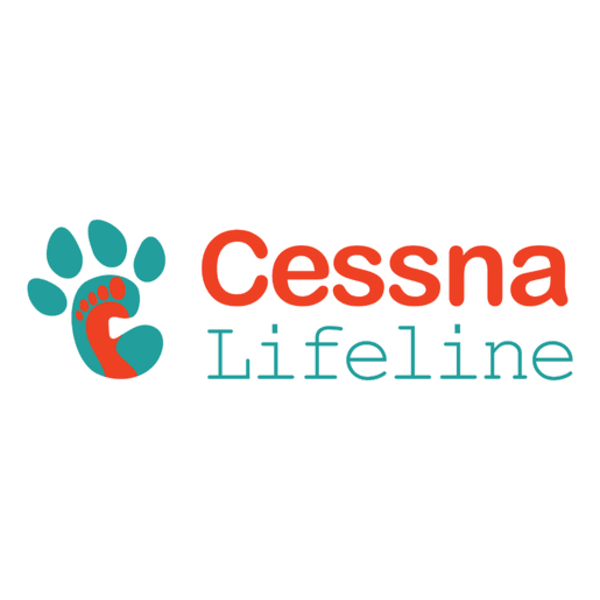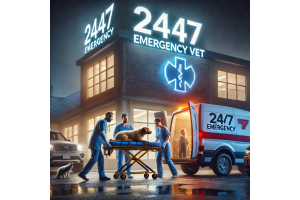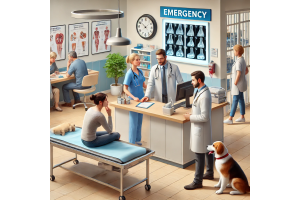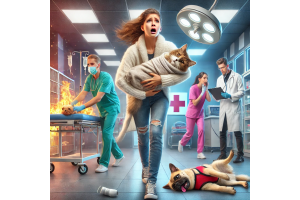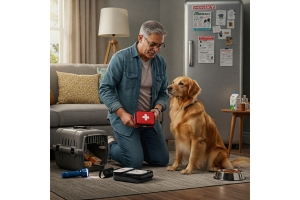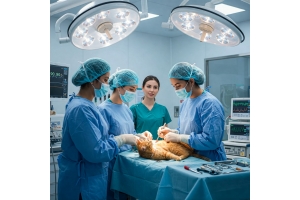Back to Top
How to Assist and Not Assist during Normal Birthing
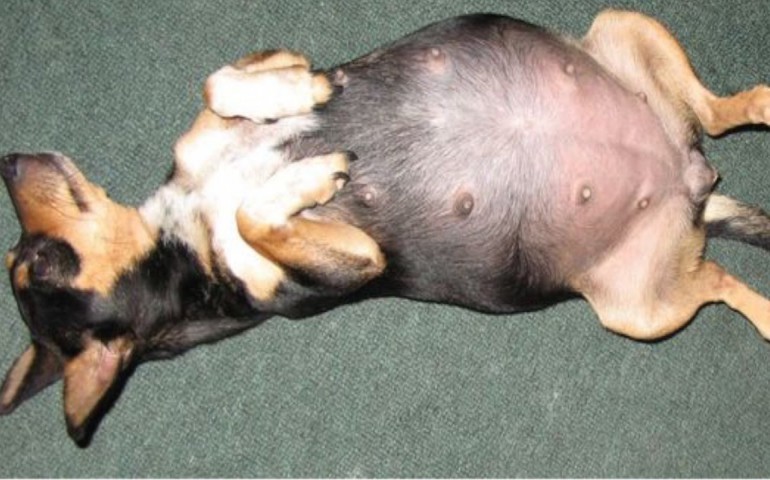
The vast majority of dogs and cats that give birth to normal, healthy puppies and kittens can do so without any assistance. Rarely, one may have trouble that will require a veterinarian’s intervention. The goal is to provide help to the mother when necessary, but to avoid getting in the way, adding discomfort, or harming the newborns.
Once the puppies and kittens are born, it is important to monitor their health. The top priority is to ensure that each newborn is receiving adequate nutrition and care from the mother. If the mother pushes the young away or prevents one of them from receiving milk, then your intervention may be warranted.
Whelping refers to a female dog giving birth; queening refers to a female cat giving birth.
Getting Started
- Equipment/materials for birthing and immediate aftercare:
- Infant nostril cleaner
- Clean string/thread
- Scissors
- Warm damp washcloth
- Dry towels
- Bottle
- Milk replacer
- Medical exam gloves
- Source of warmth for newborns
- Whelping box (dogs). This is a square, low-walled pen that the mother and pups can be in together. It looks like an empty sandbox that has a 6” (15 cm) horizontal ledge protruding into the box, halfway up the inside of all 4 walls, to provide shelter for the pups and protect them from being crushed by the mother when she lies down. Such a box can be made at home and should be about 3 × 3 feet (1 × 1 meter) in length and width, and 1 foot (30 cm) high, such that the pups are contained in the whelping crate, but the mother can walk into and out of it easily.
Birthing may easily take place without any of the items listed above, but they should be available in case of an emergency.
Troubleshooting
The most common and most serious mistake people make when their dogs or cats are giving birth is to become involved when it is not necessary. The most important thing to do is observe and monitor for real problems, as described below, and bring the dog/cat that is in labor to a veterinarian only if such signs of serious problems occur.
In general, dogs and cats prefer to be in a small, quiet, dark room or closet that allows them privacy when they are ready to give birth. Mothers may prepare a nest prior to giving birth, using available paper, clothing, or other materials; this is a normal process. There is no need to intervene at this point, and doing so could be disruptive.
It is normal for the mother to be protective of her newborns. If she becomes aggressive, caution should be used. Do not put yourself in harm's way or allow yourself to get bitten by offering assistance.
Procedure
Impending birth:
Certain clues identify that birth is imminent in pregnant dogs or cats:
Body temperature decreases by 1 or more degrees Fahrenheit (typically down to 98-100°F [36-37°C] in the dog, 100.5-102.5°F [37.8-39.3°C] in the cat) in the hours prior to giving birth.
Sharp decrease in blood progesterone level (useful for testing at veterinary hospital; if level is normal/high, birth is not occurring at that moment, nor is it expected in the next 24 hours).
The number of days since mating is *not* reliable for predicting the date of birth, as this can vary widely (58-72 days in the dog, 56-69 days in the cat).
Birthing:
The first visible sign of birthing is abdominal contractions (straining). When contractions begin, one newborn should be born every 60 minutes or less until all are born. Dogs and cats can have very large litters (as many as 12 pups/kittens) or as few as 1 or 2.
Note that 30 minutes of active straining without producing a pup or kitten should prompt an immediate visit to the veterinarian, because the birth canal may be blocked.
However, the mother may normally rest between pups/kittens for up to 3 or 4 hours, without straining, before resuming labor, especially if she is being bothered or distracted by overly protective or well-meaning humans.
A delay between pups/kittens of more than 4 hours, without contractions and in an undisturbed environment, is abnormal and justifies a visit to the veterinarian.
The third stage of labor is the passage of the placentas (afterbirths) for each pup/kitten, which occurs within 15 minutes or less of each individual birth in most cases.
The mother will usually remove the placenta (afterbirth) and cut it with her teeth. If she does not and the pup/kitten is still within a membrane-like sac when born, take a lukewarm damp washcloth and wipe off the placenta and clean the newborn’s body surface. The mother may eat the placenta, which is normal.
If the mother neglects to cut the umbilical cord, this can be done for her, but the umbilical cord must be tied (typically with thread or dental floss) about 1 inch (2 cm) from the newborn and cut away from the tie. That is, the thread remains closer to the newborn than where the umbilical cord is cut, and prevents the pup from bleeding out the umbilical cord.
Do not pull the umbilical cord off the newborn, nor tie it close to the newborn’s body surface. Either of these may cause an opening in the newborn’s body wall (umbilical hernia).
Using an infant nasal cleaner, suck out the liquid debris from the mouth and nose. It may take several attempts to remove all liquid. This is a gentle suction process, so be sure not to push air into the lungs; simply push all of the air out of the nasal cleaner before inserting into the nostrils and mouth of the newborn. Do not be afraid to stimulate the newborn’s nose and mouth this way, as this helps to increase the respiratory and heart rates.
Encourage the mother to clean and care for the newborn by placing it on the ground close to her head so she can smell and lick it.
Place the puppy/kitten next to the mother's nipples, and encourage suckling. Most newborns will begin nursing within minutes of birth.
After birth:
Ensure the mother is eating well and behaving normally. Periods of interest in the pups alternating with periods of rest are normal; if she seems poorly responsive, has difficulty breathing, or otherwise shows signs that concern you, you should call your veterinarian.
Ensure that all newborns eat vigorously and are gaining weight on a daily basis. If newborns are pushed away by the mother, or if the litter is large, owners may need to supplement feeding with a bottle and milk replacer. If newborns cry all the time, they are either hungry or may have a serious medical problem.
Ensure that newborns stay warm. Do not use a heating pad in the crate or box in which the newborns are housed, however. Puppies and kittens tend to squirm under blankets and may come in direct contact with the heat source, causing burns or fatal overheating. Instead, place the heating blanket under part of the box or crate and place several towels in the crate, providing a warm, cushiony environment that the newborns can move onto or away from as needed. If the mother is providing good care, a heat source may not be needed.
Replace blankets as needed, providing a clean environment at all times.
Feeding:
If the mother is not producing milk, or not allowing the newborns to nurse, bottle feeding may be necessary. Puppy and kitten milk replacers, along with bottles, are available at pet stores. (See additional information sheet: How to Syringe-Feed, Bottle-Feed, or Tube-Feed a Pet.) Even with normal nursing, large litters (8 or more puppies/kittens) may be too much for the mother to nurse adequately, and supplementation with puppy or kitten formula may be beneficial. This warrants a call to your veterinarian.
Puppies and kittens should nurse (or be fed if the mother is not nursing) every 2 hours during the first 2 weeks of life, then every 4 hours during the third and fourth week. Solid puppy/kitten food can be introduced at 4 weeks, with bottle feeding still being the main source of food.
Once puppies or kittens are finished eating, the genitalia must be stimulated, allowing the newborn to urinate and have a bowel movement. Take a warm damp washcloth and gently stroke the pup or kitten’s groin area between the back legs until the newborn passes urine and a bowel movement (usually takes about 10-60 seconds). This is done every time the puppy or kitten eats, and elimination should occur most, but not necessarily every, time.
Do not force the newborns to suckle. Forcing fluid into the mouth may cause fluid to enter the lungs and has been fatal. If a newborn does not want to suckle, call your veterinarian for advice; a medical issue may be present.
Afterward
It is always best for the newborns to drink their mother's milk, as this provides the best nutrition and protection. However, it is imperative that the puppies/kittens get adequate nutrition. One good practice for keeping track of nutritional balance is to weigh newborns on a daily basis, ensuring weight gain.
Limited handling of the newborns is best for the first 2 weeks. Most mothers are very protective and keep a close eye on their babies.
Frequently Asked Questions
My dog had 10 puppies. Should I supplement the puppies?
Yes. Eight or more puppies is a large litter, and some puppies may not receive adequate nutrition. Make sure to supplement all puppies so that they equally receive their mother's milk.
The father of the litter tries to get into the mother's crate. Should I separate them?
Yes, separate the mother from all other pets. Occasionally, the mother is very protective of her young and may initiate a fight while trying to protect her babies. Also, other pets may try to get into the crate and might sit on the newborns, which can crush them to death.
Should I increase the mother's food?
Yes. Feeding puppy or kitten food to the mother provides extra nutrients and calories that she is passing on to the babies. It is very important that the mother receive extra nutrition while nursing (i.e., from the moment of birth until weaning, 4-6 weeks after birth).
The mother has discharge from the vulva. Should I be concerned?
In some cases yes, and in some cases no. You should call your veterinarian if you have any questions. Some discharge can be normal, but it depends on the odor and time of discharge. Your veterinarian can determine if an infection or other abnormality is present. A very foul smell, or a mother that is feeling ill, suggests infection.
When do puppies and kittens open their eyes?
Puppies and kittens begin to open their eyes as early as 7 days. Do not try to open the eyes sooner than this.
